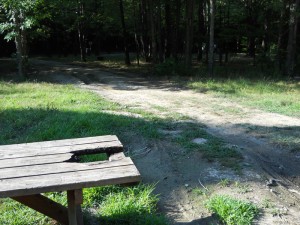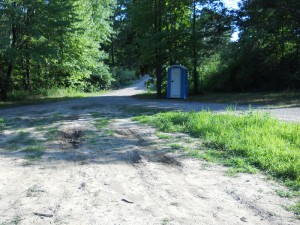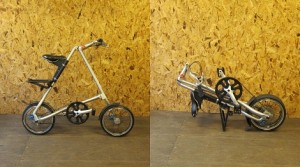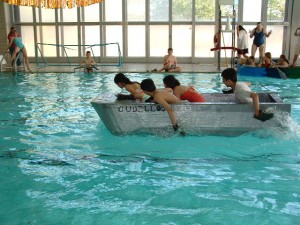So you think you want to give bicycle touring a spin? (hahaha!)
What do you need to get started?
First and foremost is a sense of adventure! Like so many other things in life, it’s a mental thing. You have to want to do it, embrace the unknown, the unexpected. What’s around the corner? What’s over that hill?
Next, you need a bike. Almost any decent, sturdy, comfortable bicycle in good repair can do the job. You do not need a specialized bicycle just to get started, after all, bicycle touring is nothing more than your strapping stuff to a bike, going for a ride and staying over night. It’s really just that simple. Like anything else though, the better the equipment you have, the easier and/or the more in-depth your experience can be.
Let’s start with a rank beginner bicycle touring scenario: You have a Comfort Bicycle, Mountain Bike, or Hybrid that you ride around the neighborhood after work, and maybe on the weekends you take it down to the local park bike path and ride a few extra miles. Maybe you even stop for lunch along the way. You’re wearing a tee shirt, shorts, tennis shoes and, of course, a helmet! You start thinking, “man, it would be cool to go a little farther and maybe stay overnight in the next town.”
What’s stopping you?
You have almost everything you need to get started. A comfort bike or mountain bike is a great entry level tourer. These bikes generally have fairly stout frames, multiple gears and tires and wheels designed to accommodate multiple surfaces. If your mountain bike tires are too fat or knobby, you can get smoother and/or smaller tires that will still fit your rims. Google it, then visit your Local Bike Shop (LBS). I switched from big fat knobbies to big fat slicks on my mountain bike because I was just riding on pavement. It made a huge difference in speed and rolling resistance, not to mention noise.
Something to avoid if possible, however, in comfort/hybrid bikes are shock absorbing seat posts. They tend to move as you pedal, up and down and side to side. They are a huge waste of energy and a possible source of chaffing. I don’t like them in the least. If you have one, you can get a one piece replacement seat post for less than $30. If you are not sure how to swap it out, go to your LBS. There are safety issues involved. Along the same lines, I personally would stay away from shock absorbing forks. Too much weight and wasted motion. That said, don’t let these stop you from giving touring a go!
The only additional gear required to get started touring is a rack and some bags, called Panniers. You can get a simple rear bike rack for around $40 new. Something like THIS. If you are the least bit mechanically inclined, they are fairly easy to install, mounting to the Braze Ons– a threaded insert welded, or brazed, to the bicycle frame, used for mounting such things as water bottle cages, fenders or racks. They usually use M5x0.8 screws, which means 5 mm in diameter and threads 0.8 mm apart.
If you’re not comfortable mounting the rack, take it to your Local Bike Shop (aka, LBS) and have them do it. If you buy it there, they’ll probably install it for free.
Some bicycles do not have braze ons or braze ons not in the right places. The work around is to use clamps that go around the various frame parts. Some racks come with clamps for alternate mounts. (Great for steel and aluminum bikes. NOT recommended for carbon!)
Next, you need some Panniers. Again, you can start with a cheap set. Look at the variety of styles and prices available from AXIOM, the company that makes the rear panniers that I used on my 2012 Ohio to Erie Trail (OtE) tour.
Now, mount, clip or otherwise hang your new bags off your new rack, open the bags, and let’s start filling them!
What do you need to take?
Well, where are you going?
Where are you staying?
To Camp or Stay Indoors
If you are camping, you will need a lot more gear; clothes, tent, sleeping bag, cooking gear, food, first aid kit, toiletry kit, rain gear, etc. If you are a regular camper and already have the gear and are used to the ways of camping, it shouldn’t be too hard to figure out. I’m a veteran backpacker and I’ve always equated bicycle touring/camping with backpacking, except that the bike carries all the weight for you! It’s the next best thing to having a mule
Here are links to specific Getting Started topics:
Getting Started Bicycle Touring: Tents and Sleeping Bags
More camping articles will follow. Stay tuned.
If you’re not comfortable with the great outdoors, the next obvious thing is to stay in a hotel/motel/bed and breakfast. Staying in a hotel will really reduce your needs, as far as what goes into your pannier(s). You’ll need your toiletry kit, some clothes, maybe a swimsuit, and some trail snacks. A rain jacket/poncho is always good insurance. Anything else you put in is up to you and how much room you have. Always pack a small first aid kit.
Either way, don’t forget to pack some essential bicycle tools, the bare minimum being a flat kit and air pump. Of course it will really help to know how to repair a flat, too. I’ll cover this in a later article and add a link to it here.
Another essential that you probably already have is a water bottle. It’s such a ubiquitous piece that I won’t spend time on it here.
Also, a bicycle lock. If you will be parking your bike out of sight, you want a heavy duty lock. Look into a good U-Lock. Kryptonite is one reputable manufacturer. If your bike gets stolen while you are on a tour, how are you getting home?
Another cool thing about staying in a hotel is that most will let you bring your bike into your room with you, giving you some added security and convenience. Some of the swankier hotels or B&Bs may not, however, so call ahead to double check if you are unsure. In our experience, most Motel 6 Holiday Inn Ramada La Quinta types are no problem. If your room is not on the ground floor, make sure they have an elevator!
How Far?
For your first “tour,” I would recommend something challenging, but within your abilities. How far do you ride every day? How far on weekends on the trail? If you can ride 10-12 miles on a Sunday afternoon on the trail, you can easily ride twice that on a trail tour. The trick is to take your time. Leave early enough so that you have all day. Try riding your usual 10-12 miles then taking an extended lunch break. Guess what? After lunch, you’re halfway there! Along many trails, you can easily ride from one town to another in 20-25 miles. There are sections of the Ohio to Erie Trail where the towns are a mere 10 miles apart.
Oh, by the way, always tell somebody that you trust what your itinerary is, just in case!
Odds and Ends
What other tidbits might you need or want?
Bicycle clothing. Bike shorts are made for the long haul. They usually have padding built into them, called a chamois. If you feel weird tooling around in spandex, you can buy bike specific shorts with a chamois that look like regular shorts, like THESE.
Bike gloves are always a good plan. They are also padded and will help absorb the shocks of the road. They will also protect your palms should you happen to crash! I wear mine always! Picking crushed limestone from the towpath trail out of your palms for the next two weeks does NOT sound like fun to me.
A helmet. If I need to make the argument for it here, then just please stay home.
Bicycle shoes. Bike shoes can make an enormous difference. Bicycle shoes, unlike tennis shoes, are made NOT to be flexible. Not good for walking or running, but a definite advantage when cycling. Any motion not committed to the transfer of energy from your leg to the bike is wasted motion. When your foot flexes on the pedal, that is effort not being transferred to the pedal. It will also tire you out and eventually make your feet hurt. Carolyn wrote a good review of some of her bicycle shoes HERE. It will give you some details of what to look for in a shoe.
Related to bike shoe stiffness and not wasting energy is the design of your pedal. Adding a cage, or toe clip, with adjustable straps to your regular old platform pedal will also help with the transfer of energy, by not allowing your foot to slide around on the pedal and also allowing you to continue the transfer of energy through the upstroke. Using toe clips takes a little getting used to. Start with the straps loose, so you can get out quickly in case of emergency.
The next step up from toe clips are clipless pedals. Clipless pedals use a cleat, mounted to the bottom of the shoe that clicks into the pedal. The pedal is of a special design to accommodate the cleat and can’t really be used without it. With this system, you are locked together with your bike, with your foot essentially becoming an extension of the pedal/crank arm. Again, they take some getting used to. You WILL crash at least once when getting used to “going clipless.”
A mirror is a piece of gear that I find indispensable. I always want to know what is coming up behind me whether I’m on the road or a trail. Highly recommended!
A bell is also great, especially if you do a lot of trail riding. It’s your responsibility to make passes safely.
A bike computer is cool to keep track of how many miles you rode that day or even the whole season. Most will also give you your speed, the time, elapsed time and maybe the date. Mine cost $13 on Ebay.
This post will be the starting point for other articles on getting started with bicycle touring. As more articles are added, this article will be updated with links to the pertinent information.




